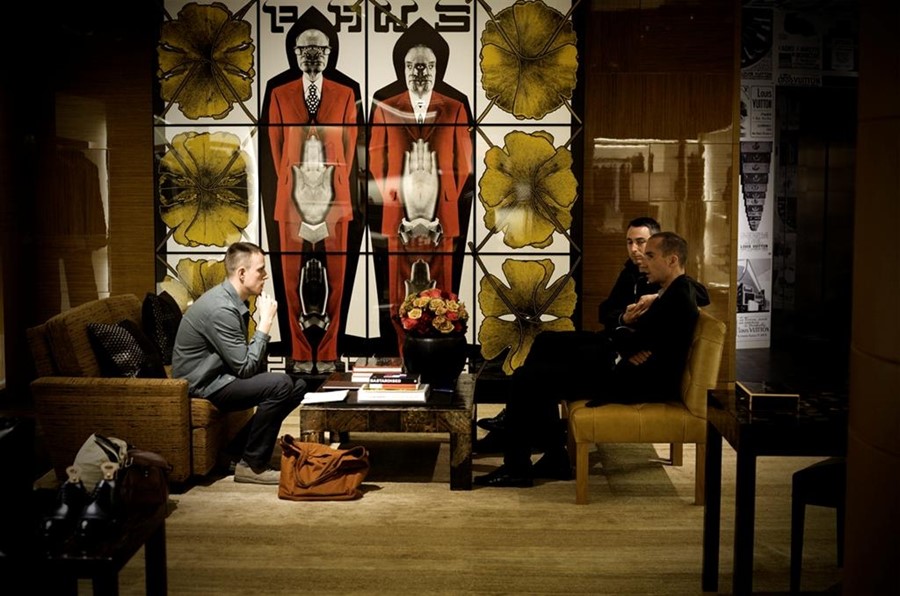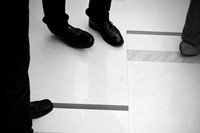To celebrate the opening of the Louis Vuitton Maison on London’s New Bond Street, curator Hervé Mikaeloff has brought together artists, performers and stylists to create works and installations for the store. At the centre of these is a performance
To celebrate the opening of the Louis Vuitton Maison on London’s New Bond Street, curator Hervé Mikaeloff has brought together artists, performers and stylists to create works and installations for the store. At the centre of these is a performance conceived by Pablo Bronstein, an artist known for his architectural drawings and sketches, based around the ideology of luxury. The resulting work, utilizing heritage and archive Vuitton pieces, brought with it difficulties and challenges, but has resulted in what Bronstein describes as his “most critical performance to date.”
How much of the concept behind what you both do is dictated by the space you are working in?
Pablo Bronstein: There is an amount of the concept that is undeniably affected by where the piece will be presented. The big challenge I faced with the performance for the opening of the London Maison Vuitton was how to maintain the criticality of the artwork in this environment. It is very different to working in an institution, where criticality is expected.
Have you responded to the architectural elements of the space?
PB: A bit!
Hervé Mikaeloff: You have to be very careful when arranging works and performance in the Vuitton shops, because ultimately, the space is what it is, it is a luxury store. It is important to, in some way, be aware of the context of luxury and to play with that a bit. I think Pablo organised his performance related to the audience and to the space; it doesn’t react to the environment around it but I think it is conceived very much with the location in mind.
PB: The priority in the performance was to be focused on the luxury objects in some way.
HM: In Pablo’s idea I really like the interaction with the patrimony of Louis Vuitton. His inclusion of the collection of the vintage trunks very much notes the story of Louis Vuitton. Everything looks so brand new here in the Maison, but Vuitton is 150 years old, so to have an interactive composition with work is really interesting.
How much does the fact that it is a commercial space, a space for selling, affect what you have put together?
PB: The performance is based on a structure of selling something to someone. So in a sense the dancer and the music are selling the glamour, history and seductiveness of these objects. A lot of the body language I am using and mannerisms and expressions of these dancers are about glorification. I am using a language of affecting superiority, sophistication or homage. It is a language of etiquette. As far as I am concerned this is actually my most critical performance to date. In a sense the restrictions of a space like this create a lot of freedoms, possibilities and challenges, and ideas arise from those challenges.
How did you go about selecting the pieces included in the performance?
PB: It was a long process. I visited the Vuitton family house in Paris, which holds a large collection of the early and rare objects made in the first atelier of Louis Vuitton. I chose both from the archive and new pieces. The majority are special order trunks that are particularly bizarre or particularly luxurious.
The Maison, as with many Louis Vuitton stores, was designed by architect Peter Marino. Do you find his work inspiring?
HM: Working as a curator for Louis Vuitton for five years I have worked a lot in spaces designed by Peter Marino – he has been involved with the house for a long time. While what we do with the artists is often in some way site-specific, and therefore it has a connection, in itself the decoration of the space does not inspire what I conceive as a curator.
PB: Any store has decoration that fulfills a very particular function, and in that sense I don’t find inspiration there, but I have been to Marino’s house in the Hamptons and I very much liked his garden. I thought it was a very witty play on Sissinghurst Castle Garden. There is a part of the garden that has all yellow flowers, and it invoked the part of Sissinghurst that is all whites. He plays a lot with historical subject matter and I appreciate that. I think to have a reference like that, in the middle of the Hamptons, is fun, sophisticated and slightly irreverent.
Rosey Trickett is a freelance photographer based in London


